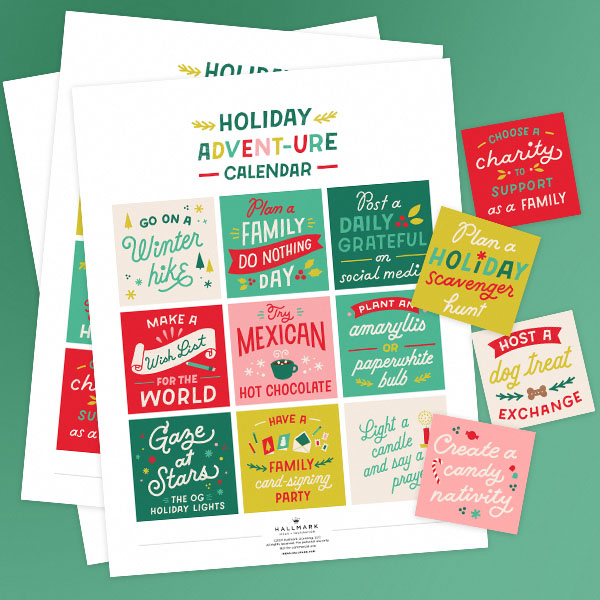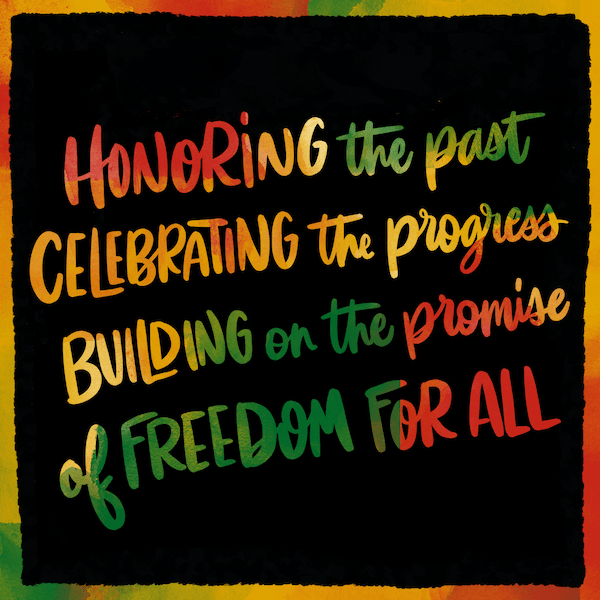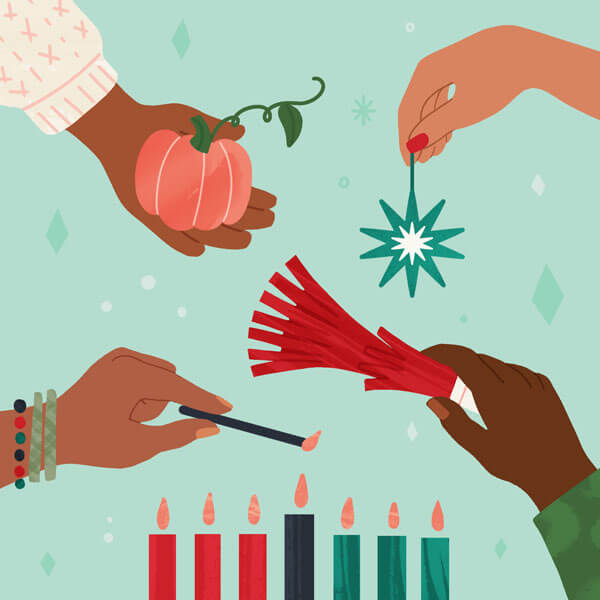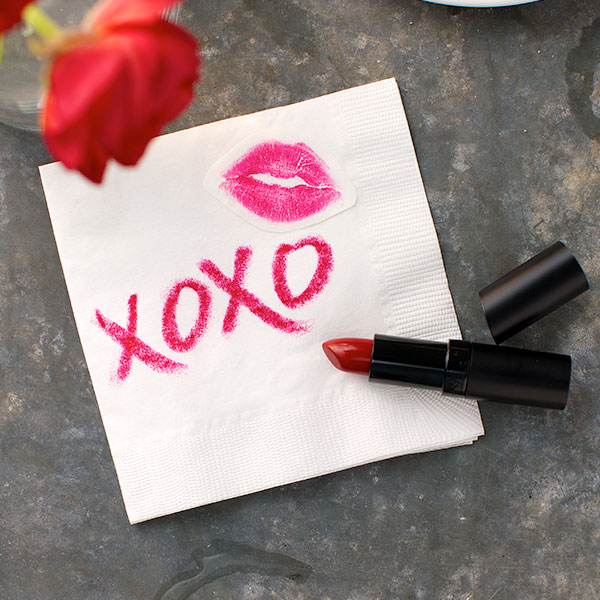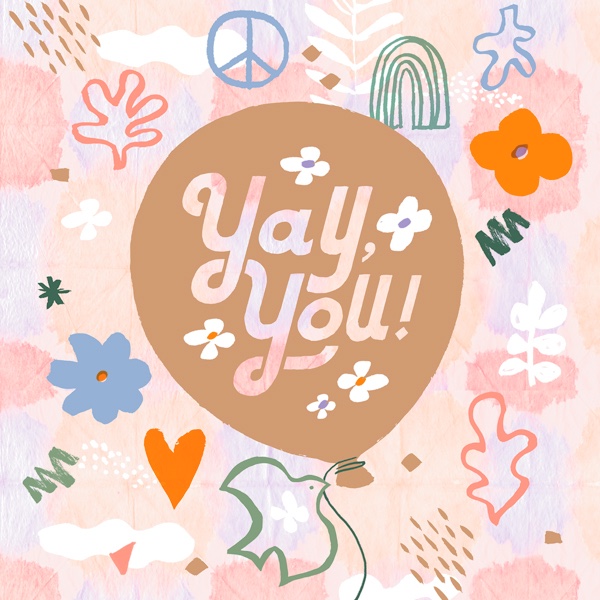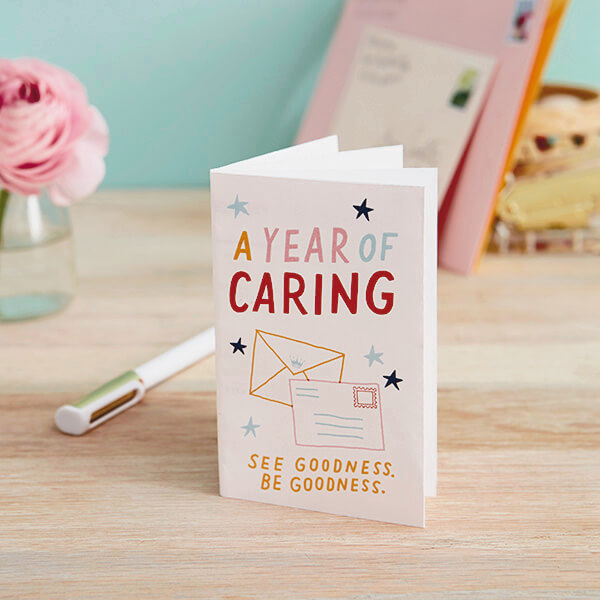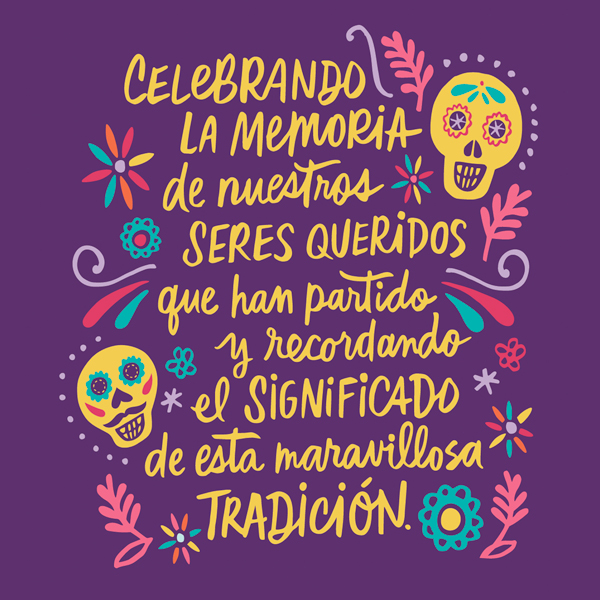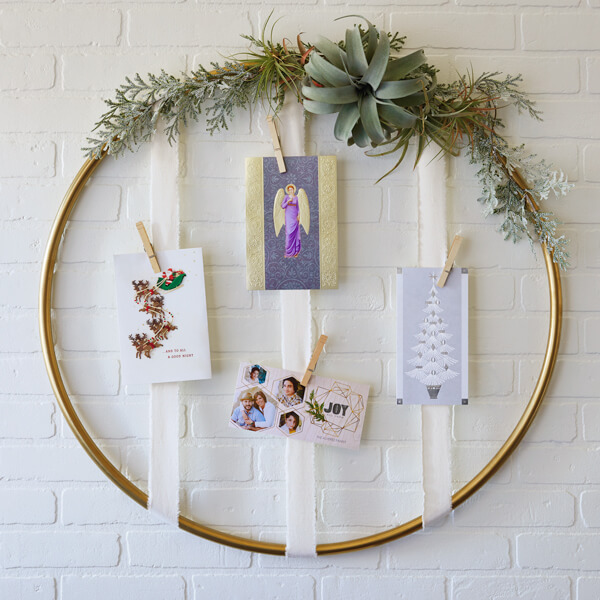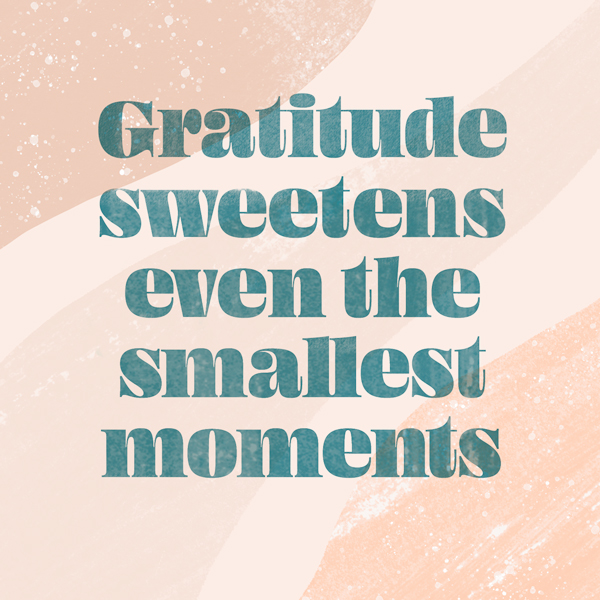What is Kwanzaa?
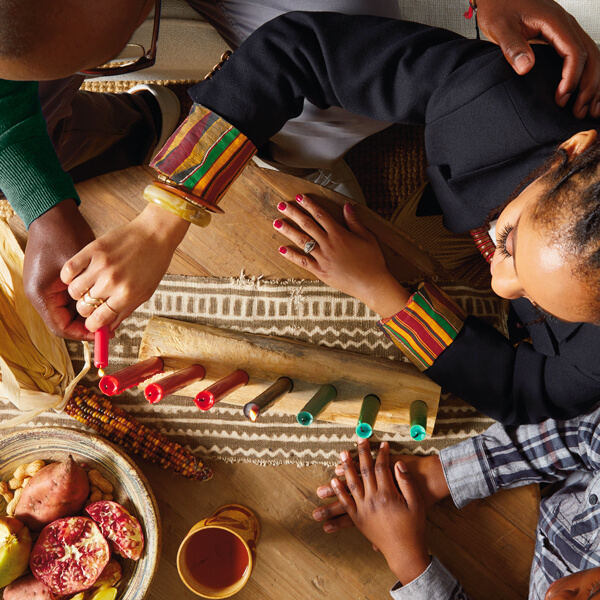
What is Kwanzaa? A festival of lights rich in African symbolism, it takes place each year from December 26th through January 1st. This joyous holiday draws inspiration from time-honored African customs and symbols, many related to harvest celebrations and community ideals of shared work, purpose, creativity, possibility, faith and celebration of togetherness.
Inspired? Create and share by tagging @hallmarkstores.
Who Celebrates Kwanzaa?
Kwanzaa is a celebration of unity among Black people in the United States along with people of African heritage the world over. Over 12.5 million celebrate Kwanzaa in the United States alone.
Kwanzaa celebrates Black family and community, culture and traditions, history and heritage, and unbreakable hope for the future. It’s an opportunity for Black families to honor ancestors and elders and cherish children even more. They commemorate the Black past and celebrate hopes for the Black future. They acknowledge their struggles but pay tribute to their persistence, resilience and transcendence over and through tough times.
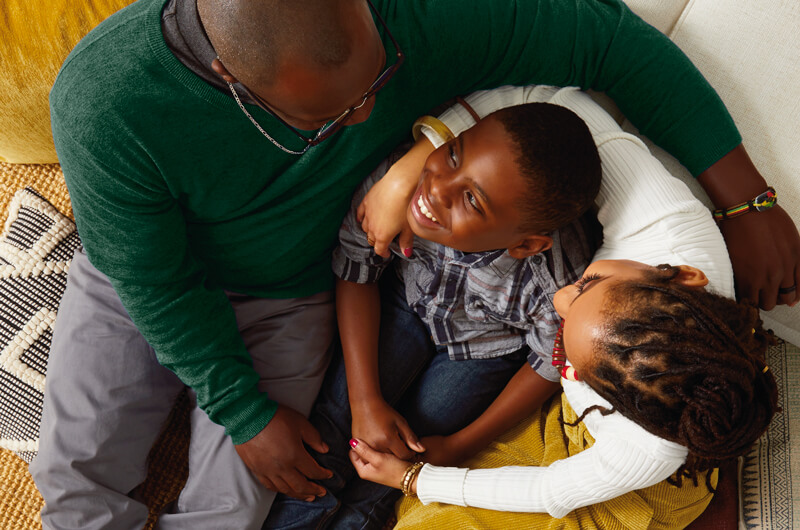
The History of Kwanzaa
Dr. Ron Maulana Karenga created Kwanzaa in 1966 as a way to help Black families and communities heal from the painful racial unrest, emotional distress and violence they’d experienced during the Civil Rights movement. Mindfulness, reflection and healing for Black people are built into the rituals and celebration of the holiday.
Black communities have embraced Kwanzaa as a way of connecting both to their ancestral African origins and to other diverse Black people and cultures in the African diaspora around the world.
One beauty of Kwanzaa is in how it brings generations together in a joyous, celebratory and self-affirming holiday honoring Black family and communal histories, experiences and culture with dignity.
As a way to counter the injustice of the past, the celebration of Kwanzaa gives Black people an opportunity to positively see, value and celebrate themselves in a society that has often struggled to do the same.
Celebrated across the United States and around the world, this empowering holiday experience echoes each year in Black homes, communities, churches, historically black colleges and other public spaces.
While Dr. Karenga did want to create a unique holiday specifically for Black people, Kwanzaa is not a replacement for Christmas. Christmas is a religious holiday, while Kwanzaa is a cultural one.
Many Black people are Christians who celebrate the birth of Jesus Christ at Christmas time, and they also celebrate Kwanzaa. Many others who are Muslim or of other religious faiths do not celebrate Christmas, but they do observe Kwanzaa.
Want to send a Kwanzaa card? Find just the right words for your Kwanzaa message from Hallmark writers.
The Seven Principles of Kwanzaa
During Kwanzaa, families, kinship groups and communities organize around the Seven Principles or Nguzo Saba:
- Umoja stands for unity in Black families and communities and among Black people all around the world.
- Kujichagulia means self-determination and the ability of Black people to build their own future by defining, naming and speaking for themselves.
- Ujima is the Swahili word for collective work and responsibility, encouraging Black people to work together and be accountable to one another.
- Ujamaa stands for cooperative economics in Black communities, combining energy and focus to build businesses and economic stability and to support each other’s economic goals.
- Nia means purpose, inspiring Black people to build personal and communal dreams and goals to work towards together.
- Kuumba is creativity, creating things of beauty that strengthen and empower Black people and Black communities.
- Imani means faith in Black people, families and heritage keeping faith that the struggle for justice will be won.
Observers are encouraged to enter Kwanzaa with a deep sense of respect and commitment to the principles, values and practices of this meaningful holiday.
Kwanzaa Decor and Dress
Part of preparing for Kwanzaa involves filling homes and gathering spaces with symbols and symbolism of Black pride.
Many Black families decorate with the colors of the Bendera, the Black liberation flag: red, black and green. Red symbolizes the struggle of Black people, black represents pride in Black skin and green stands for promise and hope for the future.
Kwanzaa celebrants may also choose to wear traditional African kente or mud cloth as well as clothing from Black-owned businesses. Everything, from clothing to artwork, is an opportunity to proudly display the rich legacy of Black culture.
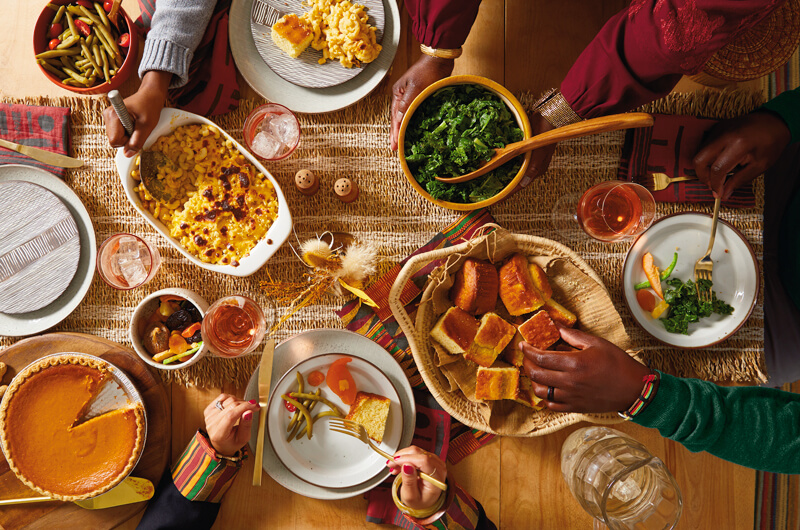
The Seven Symbols of Kwanzaa
Central to decorating is setting up the seven symbols of Kwanzaa:
- Mkeka, the mat upon which all the other symbols of Kwanzaa rest. Because the mkeka is meant to symbolize the foundation for Black history and heritage, it is prominently displayed.
- Mazao, the fruits and vegetables meant to represent African harvesting traditions where crops are the rewards of collective work and cooperation.
- Muhindi, the ears of corn, which represent the hope associated with younger generations and for future descendants.
- Kinara, the candleholder symbolizing ancestral origins, sits at the center of the mat and holds the mishumaa saba or seven candles.
- Mishumaa Saba, the seven candles: three red, three green and one black. The single black candle stands in the center to represent Black people everywhere. The red candles, representing the struggle, are placed to the right and the green candles, representing hope for the future, are placed on the left.
- Kikombe cha Umoja, the unity cup symbolizes unity among Black peoples and plays an important role in the candle-lighting ceremony.
- Zawadi, gifts placed on or near the mkeka throughout the seven-day celebration. During Kwanzaa, these gifts represent the fruits of labor and the reward of seeds sown throughout the year.
Traditionally, one ear of corn per child is placed on the mkeka. However, if there are no children in the home, two ears of corn are placed to represent the children in the community.
The Candle-Lighting Ceremony
Black families and children excitedly gather each night for the candle-lighting ceremony. There are no specific rules about who lights the candle: The honor may be given to the youngest or to the eldest. Some families choose to give this role to a different person each night.
On the first night of Kwanzaa, the black candle, signifying Umoja or unity, is the first to be lit. Three green candles representing Nia, Kuumba and Imani and three red candles representing Ujima, Kujichagulia and Ujamaa are lit on their respective days.
After each candle is lit, those gathered discuss the principle of the day.
The Kwanzaa Karamu Feast
The Kwanzaa Karamu is traditionally held on December 31st and culminates in a joyous feast and celebration.
This special event often features performances of cultural expression. Black families celebrate Karamu with their favorite works by Black authors, artists and musicians. There may be dancing, singing, storytelling or poetry readings, as well as performances of African drumming and music.
Central to the Karamu is the food, which is typically spread out on a communal table. The feast features both traditional African dishes and soul food recipes that have been handed down over time.
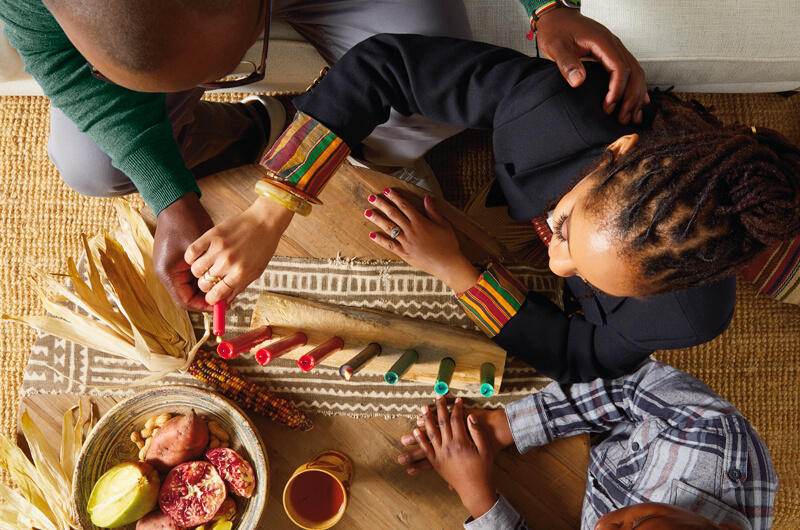
The Pouring of Libations
Libations are an integral way to honor Black ancestors and send blessings to those who may not be present. They are traditionally poured on the sixth day of Kwanzaa during the Karamu.
An elder usually leads this ceremony, pouring water, juice or wine into the unity cup to begin making the Tamshi la tambiko, or libation statement. The ritual is a way to praise the ancestors and continue the work they began.
After each person has drunk from the unity cup—or from their own cups, in modern gatherings—the elder pours the libation and invites a call to unity. Everyone present chants “harambee” or “let’s pull together” seven times. The lyrical chant ends with “Ashe” or “Amen.”
The Last Day of Kwanzaa
The last day of Kwanzaa, also known as the “Day of Mediation,” falls on January 1st. Families, kinships, groups and communities use this time to recommit themselves to the ideals of Kwanzaa.
This day is to reflect on three guiding questions:
- Who am I?
- Am I who I say I am?
- Am I all I ought to be?

Kwanzaa Gift-Giving
Traditionally, the last day of Kwanzaa is also a time for exchanging meaningful gifts or zawadi. The principle of kuumba (creativity) is embraced with families sharing handmade, educational and artistic gifts.
Many gifts also revolve around principles like unity, purpose and cooperative economics. Gifts for children, especially, must include heritage symbols and books that show a commitment to education and Black pride.
A Celebration of Cultural Heritage
Today, Kwanzaa unites African descendants across the globe through their shared cultural heritage. It is this unifying bond that makes the holiday a vital coming-together each December. Kwanzaa invites people everywhere to build upon and honor Black legacies of the past and continue creating possibilities for Black futures.
Learn more about Kwanzaa:
Shop Kwanzaa
See allYou may also like
See more-
Christmas Sweet dreams, Santa!
Catch Santa napping on the job with this Snoring Santa Keepsake Ornament featuring sound and motion. With every snore...
-
Christmas Advent calendar activities for adventurous families
It’s time to start the countdown. Maybe it’s about being mindful…or counting your blessings…or preempting your kids a...
-
Summer Ways to celebrate Juneteenth
While Juneteenth was officially recognized as a federal holiday in 2021, this pivotal moment in history has been cele...
-
Christmas Christmas and Kwanzaa: Keeping family holiday traditions and finding your own
Whether you’re single or starting a family, religious or agnostic, someone who celebrates Christmas and Kwanzaa or ju...
-
Halloween Make ghosts and goblins feel right at home this Halloween
Light up your home with haunting Halloween seasonal decor. 🎃👻 Shop now at Hallmark Gold Crown stores or at Hallmark.com.
-
Halloween No scaredy cats around here!
When this black cat crosses your path, you know fun can't be far behind. 😻 🧙♀️ Shop the Zip-A-Long Cat in Hallmark G...
-
Halloween While you’re waiting for The Great Pumpkin this Halloween…
Fly around the pumpkin patch with Zip-a-long Snoopy! 🎃 Shop more frightening finds in Hallmark Gold Crown stores and ...
-
Halloween Light up the night with frightful fun!
Could it be? Could it be!? Yes it is! It’s the Peanuts® Snoopy and Woodstock Halloween figurine! 🎃 🐶 Find it and more...
-
Halloween Where cozy meets mischief and magic
Make some magic this Halloween with this Hocus Pocus hooded blanket. 🧙♀️👻Find more Halloween essentials in Hallmark ...
-
Gifting Relive a favorite from your childhood!
Fill your home with a few small joys inspired by Disney’s “It’s a Small World” 🩵🎎 Shop the collection at Hallmark Gol...
-
Halloween Which house will you be sorted into?
The Harry Potter™ Sorting Hat™ Mug plays sound whenever you lift the lid. Find this chatty mug in Hallmark Gold Crown...
-
Encouragement How to support caregivers
It’s often hard to know how to support a caregiver. Most caregiving checklists out there hit the major topics like me...
-
Love 50 different ways to say I love you
You don’t need to wait for a special occasion to remind that certain someone how much he or she is loved. Spice up yo...
-
Graduation 15 graduation quotes
Celebrate your favorite grad’s milestone with the wit and wisdom of Hallmark writers, fans and others. We’ve rounded ...
-
Congratulations How to congratulate someone
Congratulating others is easy and fun, right? Like when your friend worked really hard and got that awesome job makin...
-
Care & Concern Be more caring with a kindness journal
It's obvious the world could use more kindness. So this year, why not make "be more caring" your number one resolutio...
-
Fall Día de Muertos: A celebration of life and love
Día de Muertos, Day of the Dead, is a holiday originally celebrated in the southern and central parts of Mexico and i...
-
Card Ideas Card messages for kids: What to write in a kid’s holiday card and more
My 3-year-old was having a hard time at preschool drop-off. Dragging his feet. Asking to stay home. This went on a fe...
-
Christmas 6 Creative Christmas Card Display Ideas
Holiday card season is here: Our mailboxes are about to fill up with festive envelopes with pretty stamps and familia...
-
Thank You 100+ inspiring gratitude quotes to keep or share
Being thankful is something we naturally think of around Thanksgiving—but anytime is a good time for some inspiring g...


